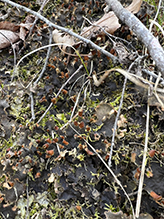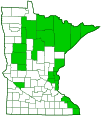Scaly Dog Pelt Lichen
(Peltigera praetextata)
Conservation • Description • Ecology • Distribution • Taxonomy
Conservation Status |
|
|||||||
| IUCN Red List | not listed |
|||||||
| NatureServe | NNR - Unranked |
|||||||
| Minnesota | not listed |
|||||||
Description |
||
There are two species of pelt lichens that are widely known by the same common name “Scaly Pelt Lichen,” Peltigera lepidophora and Peltigera praetextata. Both are common around the world, and both occur in Minnesota. Wikipedia has begun using a different common name for one of them. While not widely accepted, it has the merit of avoiding confusion between the two species. For that reason, MinnesotaSeasons.com will follow the lead of Wikipedia by assigning Peltigera praetextata the common name “Scaly Dog Pelt Lichen.” Scaly Dog Pelt Lichen is a common and widely distributed lichen. It is native to Europe, Asia, and North America. In the United States it occurs east of the Great Plains and west of the Rocky Mountains, and is mostly absent in between. It is uncommon in Minnesota, where it reaches the western extent of its range. It often grows over moss on rock or bark, sometimes also on bare soil. Scaly Dog Pelt Lichen often grows with a roughly circular form 2″ to 12″ (5 to 30 cm) in diameter. The vegetative body (thallus) is leaf-like (foliose), with elongated and more or less flattened lobes. They are attached to the soil at occasional points by scattered anchoring structures (rhizines). The rhizines are white to brown, slender, and little branched. The lobes are up to 13⁄16″ (3 cm) wide, up to 2″ (5 cm) long, rounded or almost straight across (subtruncate) at the tip, and often ascending at the tip. Adjacent lobes may overlap or be separate. The upper surface is blackish-green when wet and either gray or white to bluish-gray when dry. It is smooth, dull, and thinly to thickly covered with whitish-gray hairs, often becoming reddish-brown and hairless or almost hairless towards the center. Isidia and soredia are not produced. Scattered to dense tiny reproductive structures (phyllidia) appear along the margins and in cracks in the thallus. The phyllidia are 1⁄64″ to 1⁄16″ (0.5 to 1.5 mm) wide and may be wart-like or scale-like. This is the feature that gives the species part of its common name. The underside of the thallus is white with a network of smooth, flattened, pale to medium brown veins. Sexual (spore-producing) reproductive structures (apothecia) on the margins of the thallus are frequent. The apothecia are up to ¼″ (7 mm) in diameter, oblong to more or less round, and curved inward, appearing saddle shaped. The disc is flat, smooth, and reddish-brown to brown. |
||
Similar Species |
||
Ecology |
||
Substrate |
||
Ground |
||
Growth Form |
||
Foliose |
||
Habitat |
||
Moss on rock or bark, and bare soil |
||
Hosts |
||
|
||
Distribution |
||||
|
Sources |
|||
| 7/8/2022 | ||||
Occurrence |
||||
|
||||
Taxonomy |
|||
| Kingdom | Fungi (Fungi) | ||
| Subkingdom | Dikarya | ||
| Phylum | Ascomycota (Sac Fungi) | ||
| Subphylum | Pezizomycotina (Sac Fungi and Lichens) | ||
| Class | Lecanoromycetes (Common Lichens) | ||
| Subclass | Lecanoromycetidae (Shield Lichens, Sunburst Lichens, Rosette Lichens, and Allies) | ||
Order |
Peltigerales | ||
Suborder |
Peltigerineae | ||
Family |
Peltigeraceae | ||
Subfamily |
Peltigeroideae |
||
Genus |
Peltigera (Pelt Lichens) | ||
| Mycobiont | Peltigera praetextata | ||
| Photobiont | Nostoc | ||
Synonyms |
|||
|
|||
Common Names |
|||
Scaly Dog Pelt Lichen Scaly Pelt Lichen |
|||
Glossary
Apothecium
An open, disk-shaped or cup-shaped, reproductive structure, with spore sacs on the upper surface, that produces spores for the fungal partner of a lichen. Plural: apothecia.
Foliose
Adjective: Leaf-like growth form; referring to lichens with leaf-like growths divided into lobes.
Noun: The leaf-like, vegetative body of a lichen (thallus) that has thin, flat lobes which are free from the substrate.
Isidium
An asexual reproductive structure of a lichen in the form of a tiny outgrowth of the upper cortex. It consists of a cluster of algal cells (the photobiont) wrapped in fungal filaments (the mycobiont), and a shiny outer layer of protective tissue (cortex). Plural: isidia.
Phyllidium
An asexual reproductive structure of a lichen in the form of a small scale-like growth on the margins and in the cracks of the thallus. It has dissimilar upper and lower surfaces, contains a green photobiont, and is usually constricted at the base. Plural: Phyllidia.
Rhizine
A root-like structure of a lichen that attaches the lower layer to the substrate.
Soredium
An asexual reproductive structure of a lichen in the form of a tiny dull granule on the thallus surface that can be easily brushed off. It consists of a cluster of algal cells (the photobiont) wrapped in fungal filaments (the mycobiont), but without an outer layer of protective tissue (cortex). Plural: soredia.
Thallus
The vegetative body of a lichen composed of both the alga and the fungus. Plural: thalli.
“Baby” lichens – Phyllidia
Most lichens reproduce by producing tiny clusters of cells, either enclosed in a layer of fungal tissue (isidia), or wrapped in fungal filaments (soredia). Some lichens instead produce tiny, flattened, scale-like structures (phyllidia) that look like the lobe of a lichen. Once dispersed, phyllidia, like isidia and soredia, will produce full grown lichens.
Visitor Photos |
|||||
Share your photo of this lichen. |
|||||
| This button not working for you? Simply email us at info@MinnesotaSeasons.com. Attach one or more photos and, if you like, a caption. |
|||||
Nancy Falkum |
|||||
 |
|||||
MinnesotaSeasons.com Photos |
|||||
|
|||||

Slideshows |
||
|
||

Visitor Videos |
|||
Share your video of this lichen. |
|||
| This button not working for you? Simply email us at info@MinnesotaSeasons.com. Attach a video, a YouTube link, or a cloud storage link. |
|||
Other Videos |
|||
| Peltigera praetextata espacenature |
|||
About
Apr 9, 2019 Lichen, environnement marécageux, avril 2019, Gironde |
|||

Created: 7/8/2022
Last Updated:


